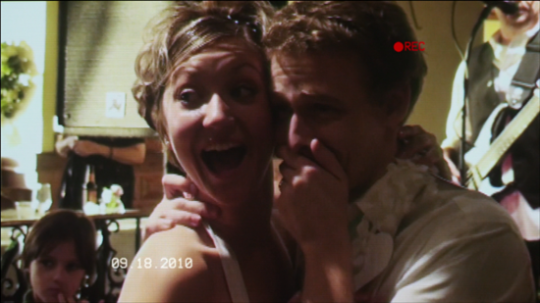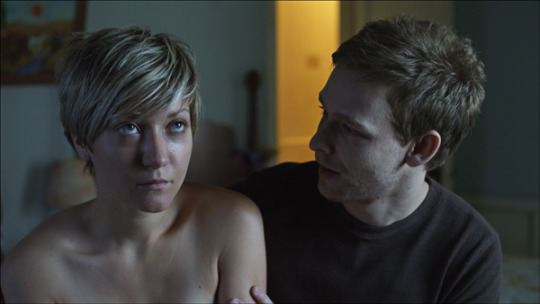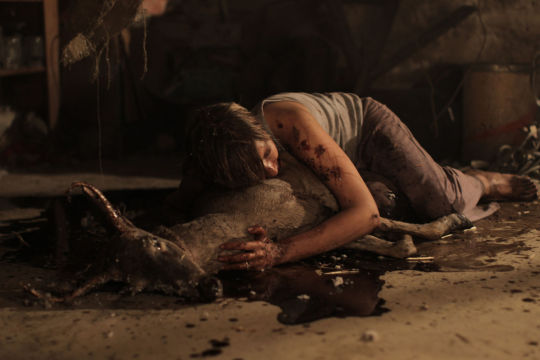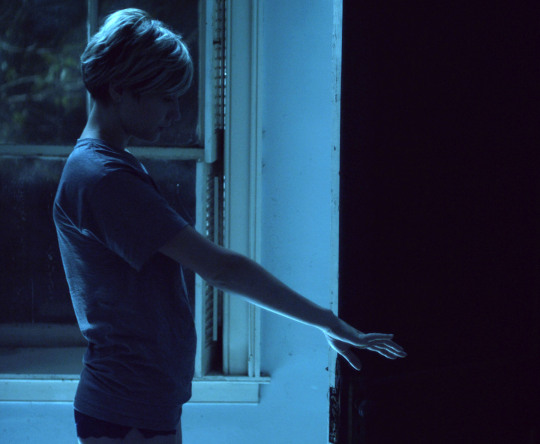The Traumatic Horror of ‘Lovely Molly’ by Chris Evangelista
By Yasmina Tawil

Molly stares into the camera, a woman undone, with bleary eyes close to the color of the red REC icon tucked away in the top right of the screen. She shivers and shakes, ready to make her confession. “Whatever happened,” she says in a quivering voice, “it wasn’t me.” She produces a knife from off camera, pressing the blade up tight to her throat before pulling it away. “He won’t let me,” she exhales.
This confessional start to 2011’s Lovely Molly will seem familiar. It’s the same sort of tearful, emotional, one-on-one-with-the-camera breakdown made famous in 1999’s The Blair Witch Project, where documentarian Heather apologizes for dragging her cohorts into certain doom. That familiarity isn’t an accident—both Lovely Molly and Blair Witch came from the same filmmaker, Eduardo Sánchez. Yet while The Blair Witch Project has entered the horror pantheon, Lovely Molly has slipped through the cracks. This film did not benefit from the same “is it real?” hype that lifted Blair Witch and it takes a different approach to fear, using its slow, cerebral sense of dread to explore mental illness. But its blurred line between supernatural horror and mental illness is equally compelling. Unlike Blair Witch, Lovely Molly is not purely a “found footage” film but a commingling of traditional narrative style and the mysterious, voyeuristic footage that Molly films with her mini-DV camera. The film traffics in a queasy, unentertaining dread that even Blair Witch didn’t approach. The plot is similar to the wildly popular first Paranormal Activity film but found none of the same renown. Perhaps this is because instead of being filled with harmless jumps and loud bangs that fade from your mind the minute you exit the theater, Lovely Molly is more visceral, more unrelenting. It’s an unpleasant film, riddled with open, still-bleeding wounds of trauma. It is, at heart, a horror film about abuse, and the ghosts that linger long after the abuse has ceased.

Lovely Molly evolved organically. On the director’s commentary for the Blu-ray release, Sánchez says the film was originally going to be more “Blair Witch-y,” implying a rougher, jerkier experience, until cinematographer John W. Rutland turned it into something “more polished.” The house the film was using for production was owned by an equestrian, and consequently filled with horse images and memorabilia. As a result, Sánchez layered a surprisingly ominous undertone involving horses: heavy sounds of hooves clattering in dark hallways; the wet, thick sound of horses exhaling; hints of the demon Orobas, a horse-headed creature dubbed in demonology as “Great Prince of Hell.” The horse element is never fully explained, though, which makes it all the more eerie and unnerving.
The setup of the film recalls other nasty pieces of work, such as the late Andrzej Żuławski’s 1981 mind-fuck minefield Possession and Lars von Trier’s cabin-in-the-woods horror by way of genital mutilation Antichrist: a couple is torn asunder under potentially supernatural circumstances, the female disintegrating into a murderous eldritch horror while the male watches, helpless and horrified. After the alarming confessional opening, Lovely Molly backtracks to a more pleasant experience, the wedding of Molly (Gretchen Lodge) and Tim (Johnny Lewis). It’s your typical wedding, although there are hints of a troubled past: Molly and her sister Hannah’s parents are both dead, and Molly and Tim immediately move into the house Molly and Hannah grew up in, despite the fact that their father met an apparently bloody end within its walls.

The house, a brick colonial-style farmhouse nestled on a dark path, looms large and uninviting, as does the memory of Molly’s father. Glimpsed only in family photographs, there’s an unspecified darkness to the man, and to the legacy he’s imprinted. Molly pulls a sheet from the dead man’s favorite arm chair after she finds it in storage, and rarely before has a simple chair seemed so ominous.
The trouble starts almost immediately. The house’s burglar alarm goes off at random during the night, and Molly and Tim find the back door—a door Tim insists he locked—wide open. Tim is a truck driver, and as a result there are long stretches where Molly is home alone. Whenever she returns home from her janitorial job, she sees the light in her childhood bedroom window burning, and whenever she enters that room, there’s an electronic, insect-like buzz in the air. Something happened in this room, something unspeakable. Molly hears whimpers from the closet, and when she opens the closet door she sees something we never do—and she reaches her hand out to it, her fingers twitching. She’s reaching out to the terrible, unrelenting past, inviting it into the present.
So much of what makes Lovely Molly terrifying is Gretchen Lodge’s utterly fearless lead performance. Molly falls apart as the film progresses, and there’s never a single moment where her deterioration doesn’t seem believable. Much like the raw terror present on Blair Witch’s Heather, Lodge’s Molly truly seems in peril. She’s coming apart at the seams, as if someone were slowly pulling out her guts inch by excruciating inch. Part of the original pitch of Lovely Molly was about a woman recording her own demonic possession, and the idea of losing one’s spouse to a different mental state still resonates here. When Tim suggests Molly go see a doctor as her mental state deteriorates, she replies, “We don’t have health insurance.” These characters are still thinking in non-supernatural terms—a trip to the doctor might help, but they can’t afford it, so it’s best to wait this out. Later, when they finally relent and see a doctor, he doesn’t offer much help. “Physically, she’s fine,” the doctor blandly tells Tim while Molly isn’t present, prescribing some sleeping pills to treat Molly’s exhaustion. “What if they don’t work?” Tim asks. “These’ll put her down pretty fast,” the doctor says, as if he were talking about a lame animal that needed to be put out of its misery. Tim replies that’s not what he meant. “What if…” he pauses before finishing, “…what if she becomes dangerous?”

Lovely Molly toys with its audience this way. What’s happening to Molly can either be explained as an actual supernatural attack, or mental illness. Or maybe it’s both, one exacerbating the other. It’s revealed that after Molly and Hannah’s mother died, their father changed for the worse. And while it’s never said aloud, it’s heavily implied he sexually abused Molly. “He told me he would stop,” Hannah recounts when the sisters have a tearful discussion after one particularly disturbing episode involving Molly and a dead deer she casually stashes away in the house. After their father’s death, Molly deteriorated into drug use and eventually ended up hospitalized, but there’s a real sense that she never truly received treatment for her traumatic childhood. Instead, it’s something pushed away, hidden in the darkest recesses of her mind. Like the memory of her father, Molly’s mental illness looms, and waits, biding its time. Waiting to ruin everything.
At one point, Tim comes home to find Molly sitting nude in her childhood bedroom, staring into the empty corner. “He’s alive,” she tells Tim in a flat, affectless voice. The “he” in question is, of course, Molly’s father. Late one night, Tim finds Molly talking to herself in the kitchen. She claims she’s talking to her father, whom Tim can’t see. “Show yourself!” Molly screams to the empty air, demanding her dead father make his presence known to her husband. But of course, he is making his presence known through Molly’s complete emotional breakdown. Even if there are no supernatural forces at work in Lovely Molly, this is a ghost story through and through, where the ghost is the horrible, unforgettable past. The demon is a type of PTSD with its claws deep in Molly’s fractured, untreated psyche.


